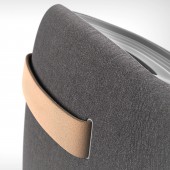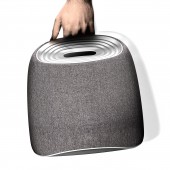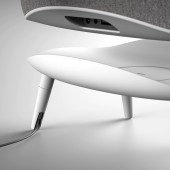
| THE AWARD |
| CATEGORIES |
| REGISTRATION |
| SUBMIT YOUR WORK |
| ENTRY INSTRUCTIONS |
| TERMS & CONDITIONS |
| PUBLICATIONS |
| DATES & FEES |
| METHODOLOGY |
| CONTACT |
| WINNERS |
| PRESS ROOM |
| GET INVOLVED |
| DESIGN PRIZE |
| DESIGN STORE |
| THE AWARD | JURY | CATEGORIES | REGISTRATION | PRESS | WINNERS | PUBLICATIONS | ENTRY INSTRUCTIONS |
Ampathy Vibration Speaker by Hyungjun Koo |
Home > Winners > Design #57154 >Interview |
 |
|
FS: What is the main principle, idea and inspiration behind your design?
HK: Ampathy can produce sound and vibration together, so deaf people can communicate culturally by enjoying music or movie together with their friends and families.
FS: What has been your main focus in designing this work? Especially what did you want to achieve?
HK: People who have auditory disorders were isolated from communications with others. They were excluded from social cultural activities such as listening to music or watching a movie. They cannot hear sounds, but they are very sensitive to vibrations. This speaker substitutes sound into solid vibration, and amplifies the listener's emotions with it.
FS: What are your future plans for this award winning design?
HK: I'll design another products and services that communicating and Sympathizing with people.
FS: How long did it take you to design this particular concept?
HK: The project started in january 2017 and finished in march 2017 in Seoul.
FS: Why did you design this particular concept? Was this design commissioned or did you decide to pursuit an inspiration?
HK: The motif of my design began with the comic written by a deaf artist. That artist love music but she can’t listen music. so she feel the little vibration of the music from the speaker. I saw that scene, thought that I can make some speaker for her to feel the music and sound.
FS: Is your design being produced or used by another company, or do you plan to sell or lease the production rights or do you intent to produce your work yourself?
HK: No, It isn't.
FS: What made you design this particular type of work?
HK: For this project, I have been living with my ears closed to experience the hearing impaired people’s life. It’s so lonely to live as a deaf because of the lack of communication. I want to make them enjoy cultural enjoyment equally, and I will design some devices like Ampathy.
FS: Where there any other designs and/or designers that helped the influence the design of your work?
HK: Unfortunately, not yet. But I'll design other solution and products like this.
FS: Who is the target customer for his design?
HK: hearing-impaired people.
FS: What sets this design apart from other similar or resembling concepts?
HK: Ampathy can produce sound and vibration together, so deaf people can communicate culturally by enjoying music or movie together with their friends and families.
FS: How did you come up with the name for this design? What does it mean?
HK: Ampathy is a compound word for 'amplifier' and 'empathy'.
FS: Which design tools did you use when you were working on this project?
HK: I drew some sketches from my shape inspirations and make 3D modeling & rendering with rhino 3D & Keyshots. At last, I edited images using a photoshops.
FS: What is the most unique aspect of your design?
HK: Visual interactions with the shape of tidal wave helps hearing-impaired people to recognize the operational status of the object for convenient using experience. So the users can control the upper touch panel intuitionally.
FS: Who did you collaborate with for this design? Did you work with people with technical / specialized skills?
HK: I requested some engineering knowledge to my friend who studying about it, and student designer Hyunsu Park gave many help for me.
FS: What is the role of technology in this particular design?
HK: Emotional communication for everyone
FS: Is your design influenced by data or analytical research in any way? What kind of research did you conduct for making this design?
HK: People who have auditory disorders were isolated from communications with others. I studied many research about their hard life and it was sad to me either.
FS: What are some of the challenges you faced during the design/realization of your concept?
HK: It was little bit hard because I didn’t make my previous project in that quality.
FS: How did you decide to submit your design to an international design competition?
HK: I wanted to test my ability about industrial concept design.
FS: What did you learn or how did you improve yourself during the designing of this work?
HK: I asked many people around myself, such as professor, friends, etc. It was so helpful to me.
FS: Any other things you would like to cover that have not been covered in these questions?
HK: No, enough. Thank you for question to me.
FS: Thank you for providing us with this opportunity to interview you.
A' Design Award and Competitions grants rights to press members and bloggers to use parts of this interview. This interview is provided as it is; DesignPRWire and A' Design Award and Competitions cannot be held responsible for the answers given by participating designers.
| SOCIAL |
| + Add to Likes / Favorites | Send to My Email | Comment | View Press-Release |





